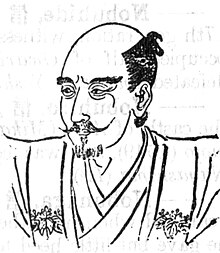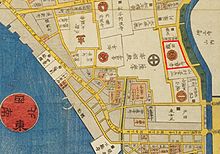Oda (clan)
The Oda ( Japanese 織田 氏 , Oda-shi ) were a family of the Japanese sword nobility ( Buke ) from the Mikawa province, which was derived from Taira Sukemori, Shigemori's son. The best-known member of the family was Oda Nobunaga, the first of the three unions. After his death, his influence declined, his descendants were among the smaller Tozama daimyo of the Edo period with an income of 20,000 koku each in Tendō ( Yamagata prefecture ) and in Kaibara, now part of Tamba ( Hyōgo prefecture ) .
genealogy
- Chikazane (平 親 真; 1260–1291), Sukemori's son, established himself in Oda (Eichizen) and named himself after this place. His descendants, vassals of the Shiba , followed them to Owari Province and received Inuyama Castle there in 1435 .
- Nobuhide (信 秀; 1511–1551), a descendant of Chikazane in the 17th generation, witnessed the decline of the Shiba and occupied half of Owari. He fought against the Saitō and defeated Imagawa Yoshimoto in 1542 at Azuki-saka (Mikawa).
Nobuhide's sons
- Nobuhiro (信 広; † 1575), Nobuhide's eldest son, received Anjō (Mikawa) castle. There he was besieged by Imagawa Yoshimoto in 1549 and had to flee. He then lost his life in the dispute over Nagashima Castle (Ise).
- Nobunaga (信 長; 1534–1582), Nobuhide's second son, showed an early interest in military affairs. From 1555 he succeeded in asserting himself against the branch of the Oda of Iwakura andmaking Kiyosu (Owari) the headquarters. - His ascent in the country began in 1560 with the happy victory over the powerful opponent, Imagawa Yoshimoto and his allies, in the battle of Okehazama (Owari). Victory after victory followed until Nobunaga had conquered large parts of Japan. Finally he fell victim to the betrayal of Akechi Mitsuhide on June 22, 1582. - Nobunaga was open to contacts with foreign countries, showed interest in the missionary Europeans in the country and promoted them, although probably not out of religious conviction. For their part, the Jesuits were impressed by his residence on the Azuchi hill on Lake Biwa.
- Nobuyuki (信 行; † 1557), another son of Nobuhides, received the castle Suemori (Owari) after the death of his father. In 1557 tried the Hayashi, vassals of his father, to become self-employed and to secure part of Owari. Nobuyuki, instead of unequivocally putting them in their place, agreed to talk to them. Nobunaga, annoyed by this attitude, sent Ikeda Nobuteru against him, who caught him in Suemori and killed him.
- Nobukane (信 包; 1548-1614), another son of Nobuhides, was adopted by the Nagao in 1568 and received the title Kōzuke no kami. He lived in Kyoto, shaved his head in 1594 and called himself Rōtaisai. He left his property, Kayano (Tamba) with 80,000 Koku, to his son. Nobukane was active as a painter and as an essayist.
- Nagamasu (長 益; 1548–1629), another son of Nobuhides, served after the death of his brother Nobunaga Toyotomi Hideyoshi . In 1586 he shaved his head and called himself Yūrakusai-Joan. From his income of 30,000 koku from properties in Yamato, he gave 10,000 koku each to his two sons Nagamasa and Toshinaga in 1615. With the remaining 10,000 Koku he lived in Kyoto, where he studied the tea ceremony under Sen no Rikyū . He founded a tea school himself, which his son Yorinaga took over. Nagamasu was baptized in 1588.
- Nobuharu (信 治; 1549-1570), another son of Nobuhides, received the Usayama (Ōmi) castle. He fell at Sakamoto while fighting Asakura Kageharu.
Nobunaga's sons
- Nobutada (信 忠; 1557–1582), Nobunaga's eldest son, took part in his father's campaigns at the age of 15. When Nobunaga settled in Azuchi in 1576, Nobutada established himself in Gifu. The following year he led a successful campaign against Matsunaga Hisahide in Yamato Province and participated in the campaign against Takeda Katsuyori. Then he went to Kyoto to support his father in the planned subjugation of the Mōri. throw. He stayed at the Myōdō-ji temple and learned there of Akechi Mitsuhide's betrayal. He hurried to help his father, but was late. He then withdrew to Nijō Castle and caused Prince Masahito-shinnō to leave the castle for security reasons. He determined Maeda Gen'i to bring his son Sambōshi (Sambōshi (三 法師) was the child's name Hidenobus) to Kiyosu and defended himself against the attacking Mitsuhide. In a hopeless situation he took his own life with 90 followers.
-
Nobuo (also Nobukatsu; 信 雄; 1558-1630), Nobunaga's second son, was destined to become heir to Kitabatake's son Tomonoris after he had been defeated in 1569. Title and ownership of the Kitabatake titles passed to Nobuo after Nobunaga led a previous Kitabatake vassal to rebel against them and Tomonori and his sons died. After Nobunaga's death, all of his vassals gathered in Kiyosu and chose Sambōshi, Nobutada's son, as his successor and appointed his uncles Nobuo and Nobutaka as protectors. Nobuo was entrusted with the administration of Owari, Ise and Iga provinces with an income of 1,00,000 koku. Nobuo settled in Kiyosu, Nobutada in Gifu.
Tensions arose between the two protectors, who appealed to the daimyo for arbitration. Shibata Katsuie , Takigawa Kazumasu, Sasa Marimasa, Maeda Toshiie and others sided with Nobutaka, while Nobuo was supported by Toyotomi Hideyoshi, Niwa Nagahide, Ikeda Nobuteru and others. Hideyoshi got Nobuo to lock his brother up in Gifu Castle while he went on against Katsuie himself. Nobutaka initially defended himself, but then fled and was killed while trying to escape in 1583. Katsuie was beaten at Shizu-ga-take and killed himself in the Kita-no-shō (Echizen) castle.
In the following year all vassals went to Azuchi to wish the young heir Sambōshi a happy New Year. Hideyoshi didn't show up, however, which annoyed Nobuo. He asked Tokugawa Ieyasu to raise troops with him. Hideyoshi also eyed troops, but when the two sides first met at Nagakute (Owari), his vanguard was completely wiped out. At the same time, the armed monks of the Negoro Temple caused trouble in the area. In 1584 Hideyoshi managed to reach an agreement with both sides in the difficult situation through skillful diplomacy.
In the 1590 campaign against the Hōjō of Odawara Nobuo took part with 15,000 followers from the provinces of Ise and Owari. There were again arguments with Hideyoshi, but Nobuo had to settle for a small domain in Dewa with 20,000 koku. He then shaved his head and called himself Jōshin. The following year the dispute was settled, Nobuo returned to Ise and settled in Fushimi after Hideyoshi's death. In 1600 he opposed Ieyasu, was then deposed and retired to Osaka.
When Hideyoshi's widow Yodo-gimi Nobuo wanted to join the resistance against Ieyasu, he felt too weak and went to Kyoto. After Toyotomi Hideyori's death in 1615, Ieyasu provided him with 50,000 koku in Yamato. Nobuo was baptized in 1588, but whether he practiced the religion cannot be determined. - Nobutaka (信 孝; 1558–1583), Nobunaga's third son, was determined to be the heir of the Kambe family (Ise). He established himself in the castle of the same name in 1569. In 1582 he received the four provinces of Shikoku as a fief and led a campaign in the province of Kii against the head of the Hongan-ji, Kōsa, whom he defeated and killed. When his father died, he heard that his cousin Nobuzumi had been on Akechi Mitsuhide's side. He attacked him in Osaka and killed him. Shortly thereafter, he and his brother Nobuo were designated as the protector of the young Sambōshi. - Nobutaka resided in Gifu and controlled the province of Mino. His tensions with Nobuo led to armed conflict. Nobutaka was besieged in Gifu, fled, was persecuted by Nakagawa Sadanari, sought refuge in the Sōhō-ji temple in Noma (Owari) and finally committed suicide in a hopeless situation.
- Hidekatsu (秀 勝; 1567-1893), Nobunaga's fourth son, was adopted by Hideyoshi in 1582 and had the previous family name of Hideyoshis, Hashiba. He became daimyo of Kameyama (Tamba) and received the title Tamba no kami. He took part in 1587 in the Kyūshū campaign against the Shimazu and in the campaign against the Hōjō of Odawara. He died in Korea.
- Katsunaga (勝 長; 1568–1582), fifth son of Nobunagas, received Inuyama (Owari) in 1581, then died with his father in the Honnō-ji temple .
More offspring
- Nobuzumi (信 澄; 1568–1583), Nobuyuki's son, married a daughter of Akechi Mitsuhides. In 1582 he took part in the campaign against the Ikkō monks, together with his cousin Nobutaka. When he learned of Nobunaga's death, he followed his father-in-law's call and went to Osaka. Nobutaka turned against him and killed him.
- Hidenobu (秀 信; 1581–1602), Nobutaka's eldest son, was only one year old when he lost his father and grandfather. At the time, the child's name was Sambōshi. It was recognized as an inheritance and was taken from Gifu to Kiyosu under the care of Maeda Gen'i and to Azuchi after the end of Akechi Mitsuhide. In 1585 Hideyoshi had him brought back to Gifu and named him, following his own name, Hidenobu. When it came to the conflict between Ieyasu and Ishida Kazushige , the young Hidenobu joined the latter, although his vassals advised against this step. He declared war on Ieyasu, was trapped in Gifu by Fukushima Masanori and Kuroda Nagamasa. He finally surrendered to Masanori, who took him to Imoarai (Yamashiro) to await Ieyasu's decision. Ieyasu sent Hidenobu to the Koyasan Monastery , where he died two years later. Hidenobu was a Christian. He was named Paul while his younger brother Hidenori Vincent was baptized. Nothing further is known about Hidenori's life.
- Hideo or Hidekatsu (秀雄; 1573-1610), Nobuo's eldest son, received Ōno (Echizen) in 1592 with 50,000 koku. Deposed after the Battle of Sekigahara, he retired to Asakusa (Edo) and lived there until his death.
The four branches of Oda after 1600
- Nobuyoshi (信 良; † 1626), Nobuo's third son, founded a branch from 1615 in Obata (Kōzuke), from 1767 in Takabatake (Dewa) and from 1828 to 1868 in a permanent house ( jinya ) in Tendō (Dewa) 20,000 Koku resided. Then Vice Count.
- Takanaga (高 良; † 1659), Nobuo's fourth son, founded a branch that resided in Uda (Yamato) from 1615 and then until 1868 in a permanent house in Kaibara (Tamba) with 20,000 koku. Then Vice Count.
- Nagamasa (長 政), Nagamasu's fourth son, founded a branch that resided in Shibamura, (Yamato) in a permanent house with 10,000 koku.
- Hisanaga (尚 長), Nagamasa's fifth son, founded a branch that resided in Yanagimoto (Yamato) from 1675 to 1868 in a permanent house with 10,000 koku. Then Vice Count.
Individual evidence
- ↑ a b Miura, Masayuki (ed.): Shiro to jinya. Saikoku-hen. Gakken, 2006. ISBN 978-4-05-604379-2 .
- ↑ Excerpt from the map of the district "Daimyo koji" from approx. 1850.
- ↑ a b c Excerpt from the "Takanawa" district map from around 1850.
- ↑ http://wiki.samurai-archives.com/index.php?title=Oda_Nobunaga from November 26, 2014
- ↑ http://wiki.samurai-archives.com/index.php?title=Oda_clan_(Owari) from November 26, 2014
literature
- Papinot, Edmond: Historical and Geographical Dictionary of Japan. Reprinted by Tuttle, 1972 edition of 1910 edition. ISBN 0-8048-0996-8 .
Web links
Clans
Important followers
- Hirate Masahide
- Hayashi Hidesada
- Sakuma Nobumori
- Sassa Narimasa
- Maeda Toshiie
- Niwa Nagahide
- Shibata Katsuie
- Sakuma Morimasa
- Hachisuka Masakatsu
- Takenaka Shigeharu
- Kuroda Yoshitaka
- Ujiie Bokuzen
- Ando Morinari
- Inaba Yoshimichi
- Matsunaga Hisahide
- Kuki Yoshitaka
Residences
- Kiyosu Castle (see picture: Kiyosu City )
- Komakiyama Castle
- Gifu Castle (see picture: City of Gifu )
- Azuchi Castle






